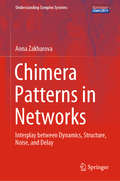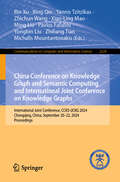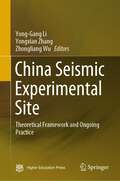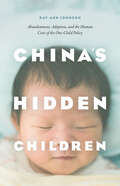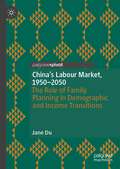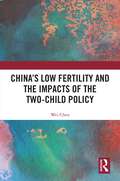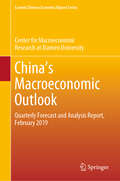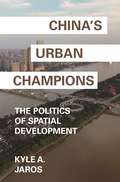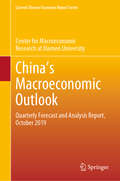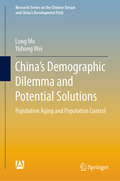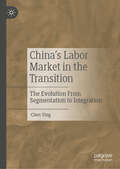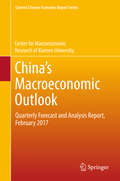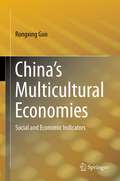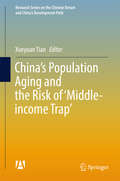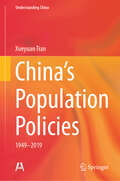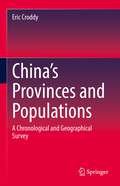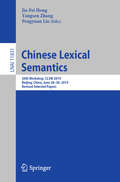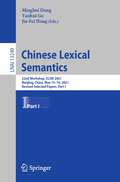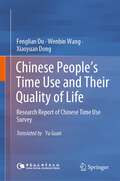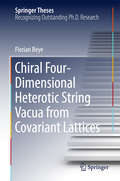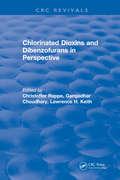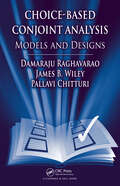- Table View
- List View
Chimera Patterns in Networks: Interplay between Dynamics, Structure, Noise, and Delay (Understanding Complex Systems)
by Anna ZakharovaThis is the first book devoted to chimera states - peculiar partial synchronization patterns in networks. Providing an overview of the state of the art in research on this topic, it explores how these hybrid states, which are composed of spatially separated domains of synchronized and desynchronized behavior, arise surprisingly in networks of identical units and symmetric coupling topologies. The book not only describes various types of chimeras, but also discusses the role of time delay, stochasticity, and network topology for these synchronization-desynchronization patterns. Moreover, it addresses the question of robustness and control of chimera states, which have various applications in physics, biology, chemistry, and engineering.This book is intended for researchers with a background in physics, applied mathematics, or engineering. Of great interest to specialists working on related problems, it is also a valuable resource for newcomers to the field and other scientists working on the control of spatio-temporal patterns.
China Conference on Knowledge Graph and Semantic Computing and International Joint Conference on Knowledge Graphs: International Joint Conference, CCKS-IJCKG 2024, Chongqing, China, September 20–22, 2024, Proceedings (Communications in Computer and Information Science #2229)
by Bin Xu Ming Liu Yannis Tzitzikas Bing Qin Yongbin Liu Zhiliang Tian Zhichun Wang Xian-Ling Mao Pavlos Fafalios Michalis MountantonakisThis book constitutes the joint refereed proceedings of the 18th China Conference on Knowledge Graph and Semantic Computing and the 13th International Joint Conference on Knowledge Graphs, CCKS-IJCKG 2024, held in Chongqing, China, during September 20–22, 2024. The 30 full papers and 11 other papers presented in this volume were carefully reviewed and selected from 168 submissions. They are organized in the following topical sections: Knowledge representation and reasoning; Knowledge graph construction and knowledge integration; Graph database and knowledge management; Machine learning on graphs; Knowledge retrieval and information retrieval; Knowledge graph and large language model applications; Knowledge graph open resources; Poster and demo; Evaluations.
China Seismic Experimental Site: Theoretical Framework and Ongoing Practice
by Zhongliang Wu Yongxian Zhang Yong-Gang LiThis book introduces an integrated conceptual framework of the China Seismic Experimental Site (CSES), describes its scientific challenges and research priorities, and reports preliminary results coming out of observational infrastructure in seismology, tectonophysics, geodesy, geophysics and geochemistry. Preliminary community fault model, community velocity model, and community strain rate model in the CSES are described in this book. A multidisciplinary test observation system includes GNSS, seismic array, and deep drilling system under construct around middle segment of the Xiansuihe-Xiaojiang fault and other seismogenic faults in the CSES which are also introduced. This book introduces multidisciplinary topics and a wide spectrum of solid earth system to describe various disciplines, methods, and techniques through the CSES. This book presents a vision of the CSES that is dedicated to deepen the scientific understanding of continental earthquake preparation and occurrence and enhance the disaster resilience of the society. It aims at establishing a field laboratory of earthquake science, in which international and interdisciplinary cooperation could be fostered and supported. Contents of this book include the following:• History of Seismic Experiment Sites in the World.• Launching of CSES Project: Seismicity, Existed Earthquake Monitoring Networks, and Historical Seismic Disasters.• Seismotectonics and Geodynamics of the Eastern Margin of the Tibetan Plateau with Implication for the CSES.• Theoretical Framework of CSES in View of Natural Science and in view of Social Science.• Updated Earthquake Monitoring Network in China.• CSES Community Models of Geology, Structure, and Deformation.• Earthquake Forecasting Models.• CSES Products: Massive Data Procession and Distribution.• A Review of the Field Expedition of the June 17, 2019, Changning, Sichuan, M6.0 Earthquake.• Rupture Structure and Earthquake Risk of the South Longmenshan Fault Viewed by Guided Waves.• Seismic Risk Assessment.• Model of a Seismic Experimental Site with Application to the Comparative Study between CSES and ASES.
China's Hidden Children: Abandonment, Adoption, and the Human Costs of the One-Child Policy
by Kay Ann JohnsonIn the thirty-five years since China instituted its One-Child Policy, 120,000 children--mostly girls--have left China through international adoption, including 85,000 to the United States. It's generally assumed that this diaspora is the result of China's approach to population control, but there is also the underlying belief that the majority of adoptees are daughters because the One-Child Policy often collides with the traditional preference for a son. While there is some truth to this, it does not tell the full story--a story with deep personal resonance to Kay Ann Johnson, a China scholar and mother to an adopted Chinese daughter. Johnson spent years talking with the Chinese parents driven to relinquish their daughters during the brutal birth-planning campaigns of the 1990s and early 2000s, and, with China's Hidden Children, she paints a startlingly different picture. The decision to give up a daughter, she shows, is not a facile one, but one almost always fraught with grief and dictated by fear. Were it not for the constant threat of punishment for breaching the country's stringent birth-planning policies, most Chinese parents would have raised their daughters despite the cultural preference for sons. With clear understanding and compassion for the families, Johnson describes their desperate efforts to conceal the birth of second or third daughters from the authorities. As the Chinese government cracked down on those caught concealing an out-of-plan child, strategies for surrendering children changed--from arranging adoptions or sending them to live with rural family to secret placement at carefully chosen doorsteps and, finally, abandonment in public places. In the twenty-first century, China's so-called abandoned children have increasingly become "stolen" children, as declining fertility rates have left the dwindling number of children available for adoption more vulnerable to child trafficking. In addition, government seizures of locally--but illegally--adopted children and children hidden within their birth families mean that even legal adopters have unknowingly adopted children taken from parents and sent to orphanages. The image of the "unwanted daughter" remains commonplace in Western conceptions of China. With China's Hidden Children, Johnson reveals the complex web of love, secrecy, and pain woven in the coerced decision to give one's child up for adoption and the profound negative impact China's birth-planning campaigns have on Chinese families.
China's Labour Market, 1950–2050: The Role of Family Planning in Demographic and Income Transitions (Palgrave Studies in Economic History)
by Jane DuThis book presents an in-depth examination of China’s population control policies from their establishment to the present and explores the developing implications of these policies on the Chinese labour market. The book connects original research on contemporary Chinese demographics with a historical analysis of China’s labour market structure. Using data from the most recent population census, chapters explore the economic impact of the demographic transition that has taken place over recent decades, from the strict implementation of family planning policies to the current easing of these policies. The book examines income growth and economic development in China after the Second World War with comparative perspectives from other Asian countries including Japan and South Korea. It also devotes a chapter to regional variations in the effectiveness of population control policies, exploring differences in rural and urban areas, and surveys the future challenges for the Chinese government in addressing population and growth-related concerns. This book will be of interest to students and researchers in economic history, labour economics, and demography, as well as those interested in Chinese economic and societal development.
China's Low Fertility and the Impacts of the Two-Child Policy
by Wei ChenThis book examines China’s fertility transition over the past seven decades and explores the socioeconomic impacts of the two-child policy. The first half of the book highlights the characteristics of China’s low fertility and the risk of falling to an ultra-low state, aiming to answer the question: How China’s fertility is changing and evolving? How common is China’s fertility? What are the demographic structure, driving forces and institutional characteristics of China’s low fertility? The second half models the impacts of the two-child policy on China’s population trends and demands for women, infant and child health services, education resources for preschool, compulsive education, and medical and health expenditure, addressing the questions of how the two-child policy affects fertility behaviours of Chinese women, particularly the second-child fertility? How would the two-child policy impact China’s future population trends, particularly labour supply and population ageing? What are the consequences for obstetrics and gynaecological services, paediatrics and childcare services; and for school capacity and demand for teachers over compulsory education? The book will be an essential read to students and scholars of Chinese studies, population and demography studies, and those interested in contemporary China.
China's Macroeconomic Outlook: Quarterly Forecast and Analysis Report, February 2019 (Current Chinese Economic Report Series)
by Center for Macroeconomic Research at XiaThis report is a partial result of the China’s Quarterly Macroeconomic Model (CQMM), a project developed and maintained by the Center for Macroeconomic Research (CMR) at Xiamen University. The CMR, one of the Key Research Institutes of Humanities and Social Sciences sponsored by the Ministry of Education of China, has been focusing on China’s economic forecast and macroeconomic policy analysis, and it started to develop the CQMM for purpose of short-term forecasting, policy analysis, and simulation in 2005.Based on the CQMM, the CMR and its partners hold press conferences to release forecasts for China’s major macroeconomic variables. Since July, 2006, twenty-six quarterly reports on China’s macroeconomic outlook have been presented and thirteen annual reports have been published. This report, the twenty-sixth quarterly report, has been presented at the Forum on China’s Macroeconomic Outlook and Press Conference of CQMM on February 26, 2019. This conference was jointly held at Beijing by the CMR and the Economic Information Daily at Xinhua News Agency
China's Urban Champions: The Politics of Spatial Development (Princeton Studies in Contemporary China #4)
by Kyle A. JarosThe rise of major metropolises across China since the 1990s has been a double-edged sword: although big cities function as economic powerhouses, concentrated urban growth can worsen regional inequalities, governance challenges, and social tensions. Wary of these dangers, China’s national leaders have tried to forestall top-heavy urbanization. However, urban and regional development policies at the subnational level have not always followed suit. China’s Urban Champions explores the development paths of different provinces and asks why policymakers in many cases favor big cities in a way that reinforces spatial inequalities rather than reducing them.Kyle Jaros combines in-depth case studies of Hunan, Jiangxi, Shaanxi, and Jiangsu provinces with quantitative analysis to shed light on the political drivers of uneven development. Drawing on numerous Chinese-language written sources, including government documents and media reports, as well as a wealth of field interviews with officials, policy experts, urban planners, academics, and businesspeople, Jaros shows how provincial development strategies are shaped by both the horizontal relations of competition among different provinces and the vertical relations among different tiers of government. Metropolitan-oriented development strategies advance when lagging economic performance leads provincial leaders to fixate on boosting regional competitiveness, and when provincial governments have the political strength to impose their policy priorities over the objections of other actors.Rethinking the politics of spatial policy in an era of booming growth, China’s Urban Champions highlights the key role of provincial units in determining the nation’s metropolitan and regional development trajectory.
Chinaʼs Macroeconomic Outlook: Quarterly Forecast and Analysis Report, October 2019 (Current Chinese Economic Report Series)
by Center for Macroeconomic Research at XiaThis report is a partial result of the China’s Quarterly Macroeconomic Model (CQMM), a project developed and maintained by the Center for Macroeconomic Research (CMR) at Xiamen University. The CMR, one of the Key Research Institutes of Humanities and Social Sciences sponsored by the Ministry of Education of China, has been focusing on China’s economic forecast and macroeconomic policy analysis, and it started to develop the CQMM for purpose of short-term forecasting, policy analysis, and simulation in 2005.Based on the CQMM, the CMR and its partners hold press conferences to release forecasts for China’ major macroeconomic variables. Since July, 2006, twenty-six quarterly reports on China’s macroeconomic outlook have been presented and thirteen annual reports have been published. This 27th quarterly report has been presented at the Forum on China’s Macroeconomic Prospects and Press Conference of the CQMM at Xiamen University Malaysia on October 25, 2019. This conference was jointly held by Xiamen University and Economic Information Daily of Xinhua News Agency.
China’s Demographic Dilemma and Potential Solutions: Population Aging and Population Control (Research Series on the Chinese Dream and China’s Development Path)
by Long Mo Yuhong WeiThis book is a quantitative assessment of the challenges China faces as it tries to achieve the twin goals of mitigating the effects of population aging while containing the overall size of the population. After a close examination of the impact of China’s fertility policies on the country’s population structure and size, the author presents empirical evidence for the effectiveness of finely calibrated easing of the country’s decades-long birth control policies for both of these objectives. This research uses an innovative quantitative indicator—the Aging and Economic Coordination Index (AECI)—to measure the macroeconomic pressure population aging places on the country. This is the first time the AECI has been systematically applied to gauge the magnitude and the trends of that pressure for the 1980–2050 period, and to provide the basis for policy suggestions about what might be done to ease that pressure.
China’s Labor Market in the Transition: The Evolution From Segmentation to Integration
by Chen YingThis book explores the dynamics of the Chinese labor market, the largest in the world. The sheer scale of rural laborers living in cities is the ultimate engine driving the fastest urbanization the world has ever seen. Today, the country faces a series of new challenges as it tries to address problems of unemployment and under-employment. These include population ageing, automation, the increasing use of AI on the factory floor and other workplaces and Chinese manufacturers’ move up the value chain. The book presents an empirically rich and analytically rigorous account of how these challenges might be met. It will be of interest to labor economists, scholars of Chinese manufacturing, and researchers of the Chinese economy.
China’s Local Entrepreneurial State and New Urban Spaces: Downtown Redevelopment in Ningbo (New Perspectives on Chinese Politics and Society)
by Han ZhangIn this book, the author seeks to understand China’s urban redevelopment from the theoretical perspective of the local entrepreneurial state. China’s rapid socio-economic transformations since 1978 have been in large part attributed to China’s state transformations. The author closely investigates Ningbo’s two downtown redevelopment projects by conducting ethnographic fieldwork and documentary research. It is found that the local entrepreneurial state deploys local state enterprises to undertake strategic urban redevelopment projects, organizes high-profile city/district marketing campaigns in entrepreneurial manners, and develops corporatist intermediations with local business owners for collaborative urban governance. Yet the local entrepreneurial state is multi-layered, with the municipal and district authorities sometimes disagreeing, conflicting, and bargaining with each other. Meanwhile, the relationship between spaces and their users, as well as that between various space users, constantly changes. All these players and their interactions constitute “spatial politics”, or the story of conflicts, struggles, negotiations, and collaborations in urban governance. This work, based on six months of fieldwork, will appeal to scholars in the social sciences and experts in Asian Studies.
China’s Macroeconomic Outlook: Quarterly Forecast and Analysis Report, February 2017 (Current Chinese Economic Report Series)
by Center for Macroeconomic Research of Xiamen UniversityThis book is a quarterly forecast and analysis report on the Chinese economy. It is published twice a year and presents ongoing results from the "China Quarterly Macroeconomic Model (CQMM)," a research project at the Center for Macroeconomic Research (CMR) at Xiamen University. Based on the CQMM, the research team forecasts China's major macroeconomic indicators for the next 8 quarters, including GDP growth rate, CPI, PPI, investment in fixed assets, household consumption, imports, exports, and foreign reserves. Moreover, it simulates different scenarios to study the effects of macroeconomic policy on the Chinese economy. In addition to helping readers to understand China's economic trends and policies, this book has three main goals: to help readers understand China's economic performance; to forecast the major macroeconomic indicators for the next 8 quarters; and to simulate the effectiveness of macroeconomic policy.
China’s Multicultural Economies: Social and Economic Indicators
by Rongxing GuoAlthough the majority of China's population is of the Han nationality (which accounts for more than 90% of China's population), the non-Han ethnic groups have a population of more than 100 million. Until now, China has officially identified, except for other unknown ethnic groups and foreigners with Chinese citizenship, 56 ethnic groups. In addition, ethnic groups vary widely in size. With a population of more than 15 million, the Zhuang have the largest ethnic minority, and the Lhoba, with only two thousand or more, the smallest. China's ethnic diversity has resulted in a special socioeconomic landscape of China itself. This book develops a complete socioeconomic picture and a detailed and comparable set of data for each of China's ethnic groups. There have not been any precise data on China's socioeconomic statistics from multi-ethnic dimension. The only official data released can be found in China Ethnic Statistical Yearbook (released by the State Commission of Ethnic Affairs (SCEA) of the People's Republic of China since 1994). However, as this Yearbook has only reported the socioeconomic statistics for the minority-based autonomous areas, a complete set of China's multi-ethnic data cannot be derived from it. This book provides a broad collection of data on China's 56 ethnic groups and profiles the demography, cultural, economy, and business climates for each of China's diverse ethnic groups.
China’s Population Aging and the Risk of ‘Middle-income Trap’ (Research Series on the Chinese Dream and China’s Development Path)
by Xueyuan TianThis book includes a series of reports that mainly discuss the Middle Income Trap against the backdrop of population ageing in China. It also offers practical suggestions on how to avoid it properly. Concretely, it argues that the government should accelerate the transition of economic development modes, resolve concentrated social conflicts, promote a balanced rural and urban development during the process of urbanization, and mitigate the effects of population ageing by fostering strengths and avoiding weaknesses. As for the challenges posed by population ageing in China, it puts forward five core suggestions tailored to China's unique situation. Assessing a number of real-world challenges, the general report and the special reports combine theory and empirical findings, using primary data for their analyses. Given the wealth of essential information it provides, the book offers a valuable reference resource for decision-makers.
China’s Population Policies: 1949–2019 (Understanding China)
by Xueyuan TianThis book presents a factual analysis of the history of population policy, especially the fertility policy, mainly the reproduction of the policy since the founding of New China, especially the promotion of one child per couple, including the background of the policy's introduction, the formulation of the decision, the prediction of possible problems, and the choice of decision to deal with them. It summarises the basic experience of China and the international community in implementing population policies, and proposes to follow the path of family planning with Chinese characteristics and implement population policies that are compatible with it.
China’s Provinces and Populations: A Chronological and Geographical Survey
by Eric CroddyThis manual provides an overview of China's administrative geography, history, and populations of all 31 provinces, as well as Hong Kong, Macao and Taiwan. It focuses primarily on how the provinces came to be, how they were named, as well as their people and populations throughout history. In addition to extensive use of bilingual names (Chinese-English) for specificity, this resource is unique in the datasets contained therein: (1) Up-to-date residential populations of mainland China using the latest decennial (2020) census, and (2) political-administrative registered household (hukou) data based on official numbers provided by People’s Republic of China (PRC) Ministry of Public Security showing trends from 2012-2020. Each internally consistent, but differing in their methodologies, whereby the Census (decennial) data provide a snapshot of how many people live in a given location, and the permanent (hukou) registered household data track each individual based on their hometown, household, urban/rural status, and nationality. This book addresses this chasm which, among other issues, points to the phenomenon of China’s "floating populations", where millions of Chinese spend much if not all of their time living, working, and studying outside their home provinces. By showing how the Chinese have been populated and their organization throughout history, this manual is the go to place for professionals, practitioners and academics working and interested in China’s provinces and populations.
Chinese Lexical Semantics: 20th Workshop, CLSW 2019, Beijing, China, June 28–30, 2019, Revised Selected Papers (Lecture Notes in Computer Science #11831)
by Jia-Fei Hong Yangsen Zhang Pengyuan LiuThis book constitutes the thoroughly refereed post-workshop proceedings of the 20th Chinese Lexical Semantics Workshop, CLSW 2019, held in Chiayi, Taiwan, in June 2019. The 39 full papers and 46 short papers included in this volume were carefully reviewed and selected from 254 submissions. They are organized in the following topical sections: lexical semantics; applications of natural language processing; lexical resources; corpus linguistics.
Chinese Lexical Semantics: 22nd Workshop, CLSW 2021, Nanjing, China, May 15–16, 2021, Revised Selected Papers, Part I (Lecture Notes in Computer Science #13249)
by Jia-Fei Hong Minghui Dong Yanhui GuThe two-volume proceedings, LNCS 13249 and 13250, constitutes the thoroughly refereed post-workshop proceedings of the 22nd Chinese Lexical Semantics Workshop, CLSW 2021, held in Nanjing, China in May 2021. The 68 full papers and 4 short papers were carefully reviewed and selected from 261 submissions. They are organized in the following topical sections: Lexical Semantics and General Linguistics; Natural Language Processing and Language Computing; Cognitive Science and Experimental Studies; Lexical Resources and Corpus Linguistics.
Chinese Mathematical Astrology: Reaching Out to the Stars (Needham Research Institute Series)
by Ho Peng YokeThough there are a number of well-written works on Chinese divination, there are none that deal with the three sophisticated devices that were employed by the Chinese Astronomical Bureau in the eleventh century and for hundreds of years thereafter. Chinese experts applied the methods associated with these devices to both weather forecasting and to the interpretation of human affairs. Hidden by a veil of secrecy, these methods have always been relatively little known other than by their names. The first work in any language to explore these three methods, known as sanshi (three cosmic boards), this book sheds light on a topic which has been shrouded in mystery for centuries, having been kept secret for many years by the Chinese Astronomical Bureau.
Chinese People’s Time Use and Their Quality of Life: Research Report of Chinese Time Use Survey
by Wenbin Wang Fenglian Du Xiaoyuan DongThis book analyzes how Chinese people use their time, including how busy Chinese seek a healthy work-life balance, how some children win from the outset in terms of education, and how people pursue quality of life outside of or after work. General readers will get a vivid and detailed impression of the way Chinese people spend their time, while researchers will find a wealth of phenomena and data for analysis from both economic and social perspectives. The research presented here was conducted in the context of the Chinese Time Use Survey (CTUS), a nationwide initiative launched by Inner Mongolia University in 2017. The CTUS covers 29 Chinese provinces, and the database contains the time use information of 30,591 people aged 3 years and over from 12,471 households. The survey collects information at three main levels: personal, family and community.
Chinese Students' Higher Achievement in Mathematics: Comparison of Mathematics Education of Australian and Chinese Primary Schools (Mathematics Education – An Asian Perspective #0)
by Dacheng ZhaoThis book shares insights into the achievement gap in mathematics between East Asian and Western countries, and the ways to improve students' mathematics achievements. Especially, it highlights the importance to integrate case studies with large-scale international comparative studies in general, and comparative studies of mathematics education in particular. This book is a must-read for mathematics teachers, mathematics educators, educational researchers, education administrators, curriculum developers, assessment designers, and student teachers who are interested in mathematics education and how to improve students' mathematics achievements.
Chiral Four-Dimensional Heterotic String Vacua from Covariant Lattices (Springer Theses)
by Florian BeyeThis book is placed at the interface between string theory and elementary particle physics and shows novel results in the search for a heterotic string vacuum that reproduces those matter particles and interactions observed in our universe. The author provides a systematic classification of potentially realistic heterotic covariant lattice vacua, which possess a lower number of moduli fields when compared to conventional compactification methods, by means of number theoretical methods. These methods, while well known to the mathematics community, have not yet found many applications to physics. They are introduced to the degree necessary to understand the computations carried out throughout this work. Furthermore, explicit covariant lattice models with particularly interesting properties are analyzed in detail. Finally, new light is shed on the relation between covariant lattice models and asymmetric orbifold compactifications, the result being a concrete correspondence between certain types of asymmetric orbifolds and those classified covariant lattices.
Chlorinated Dioxins and Dibenzofurans in Perspective
by Christoffer RappeThis volume was developed from the proceedings of a symposium held in Miami Beach, at the 189th National Meeting of the American Chemical Society.It is the result of the combined efforts of many experts whose efforts have advanced our knowledge of the production, analysis, distribution, effects and control of chlorinated dioxins, dibenzofurans and related compounds.This is the third in a series of publications originating from current technology presented at national meetings of the American Chemical Society. Using this forum as a catalyst, researchers from all over the world came together to present and discuss their data and plan future work in this rapidly developing and sometimes highly emotional technical area.
Choice-Based Conjoint Analysis: Models and Designs
by Damaraju Raghavarao James B. Wiley Pallavi ChitturiConjoint analysis (CA) and discrete choice experimentation (DCE) are tools used in marketing, economics, transportation, health, tourism, and other areas to develop and modify products, services, policies, and programs, specifically ones that can be described in terms of attributes. A specific combination of attributes is called a concept profile.
